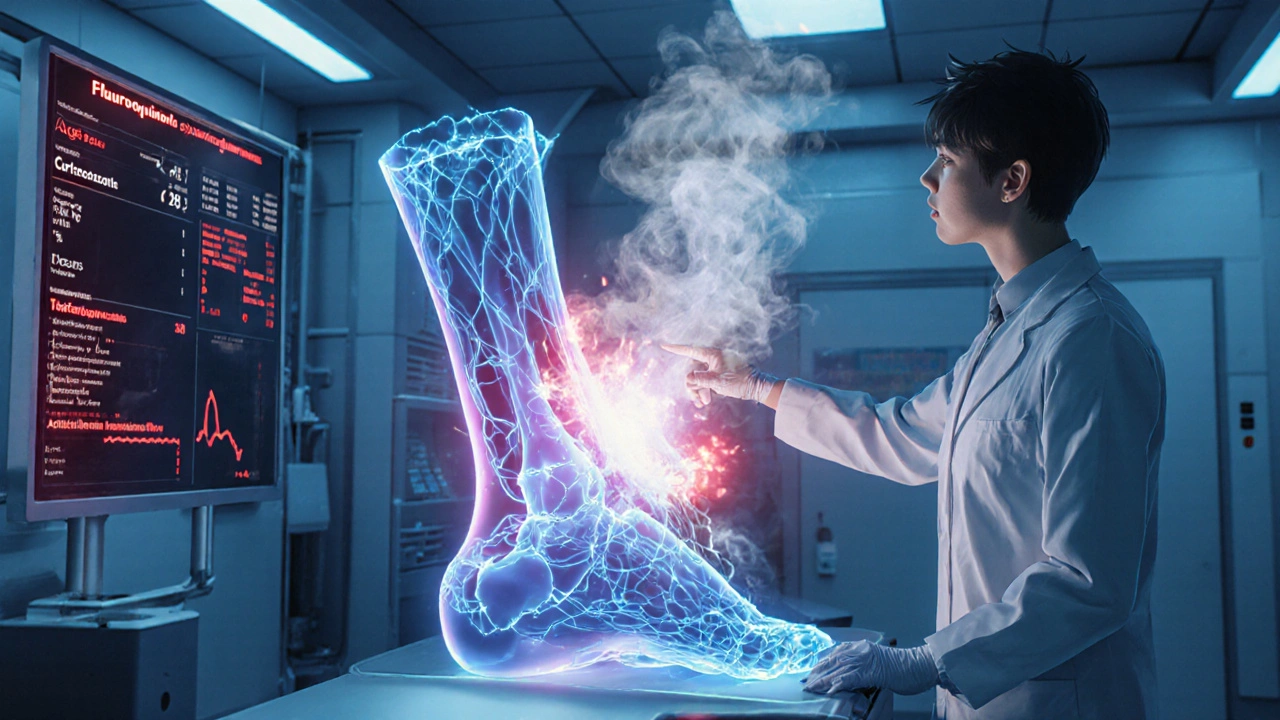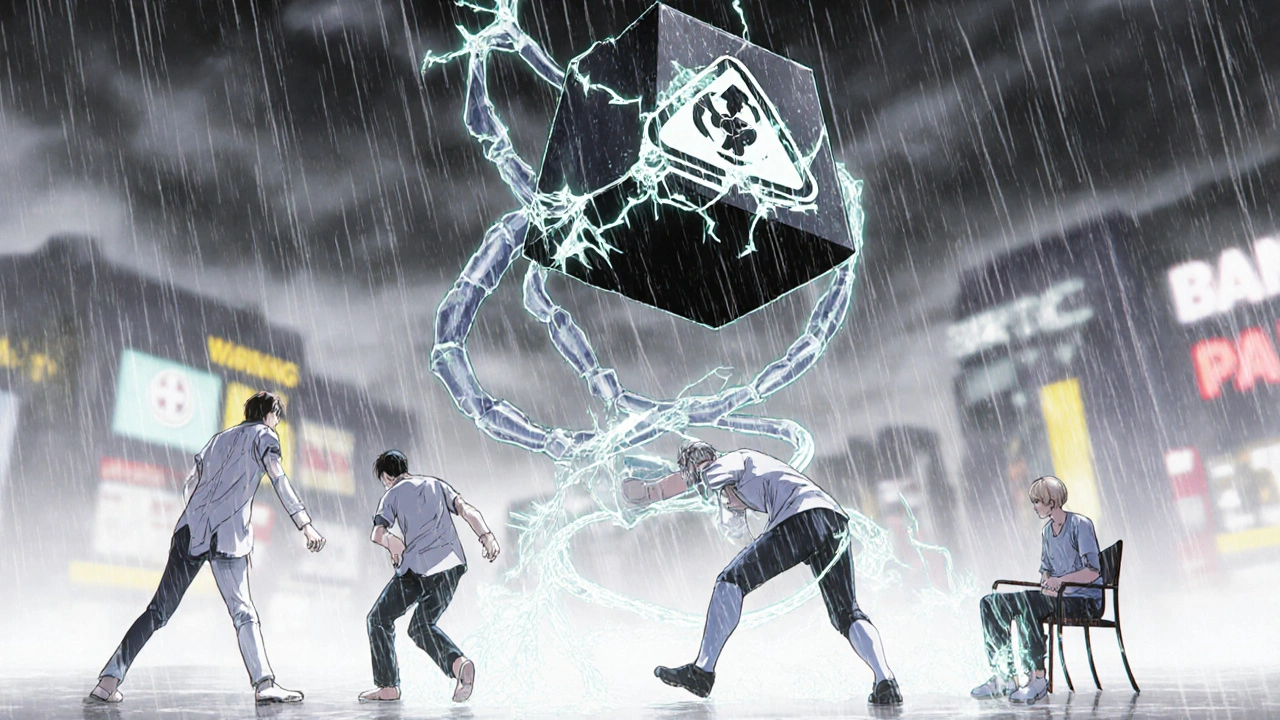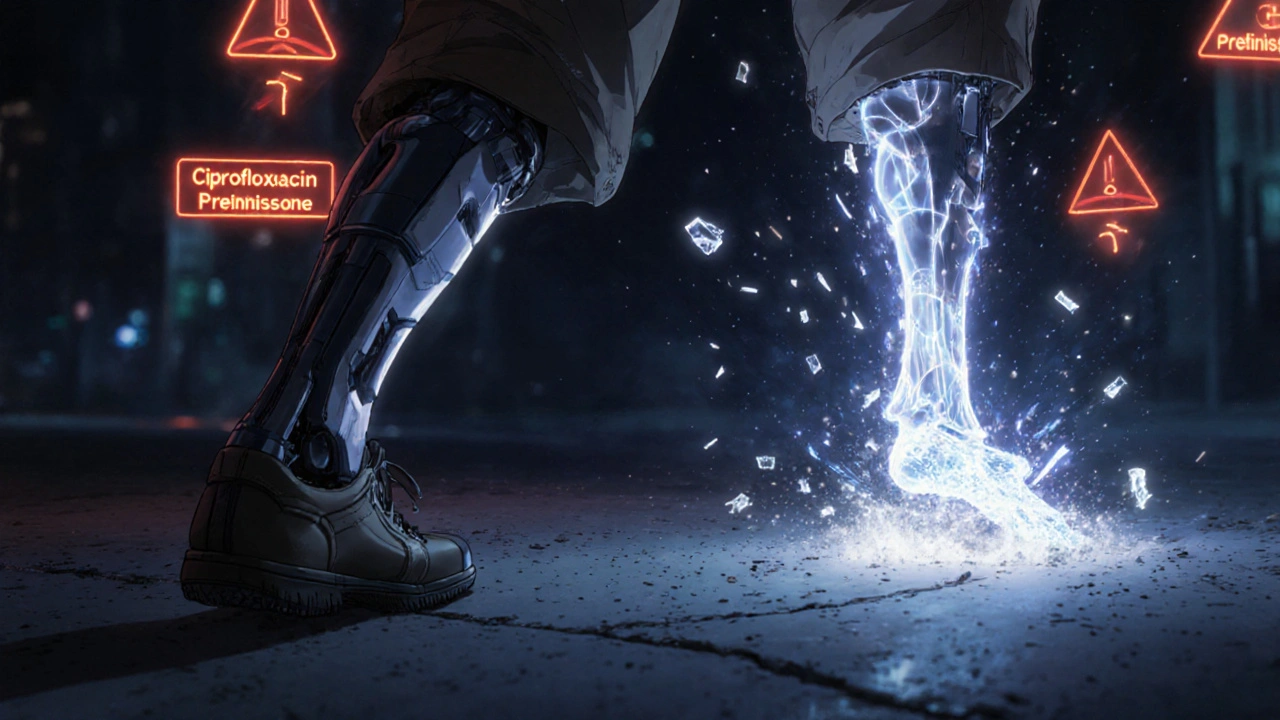Tendon Rupture Risk Calculator
Personal Risk Assessment
Imagine going for a walk, stepping off a curb, and suddenly hearing a loud pop-then being unable to push off with your foot. That’s not a sports injury. It’s a tendon rupture caused by two of the most commonly prescribed medications: quinolone antibiotics and corticosteroids. And it can happen to anyone, even if they’ve never played a sport or had a previous injury.
Why This Isn’t Just a Rare Side Effect
Fluoroquinolones-like ciprofloxacin, levofloxacin, and norfloxacin-are powerful antibiotics used for urinary tract infections, pneumonia, and other bacterial infections. They’ve been around since the 1980s and were once considered go-to drugs because they work fast and are taken as pills. But since the early 2000s, doctors have seen a pattern: patients on these antibiotics, especially those also taking steroids, are showing up with torn tendons. The Achilles tendon-the thick band connecting your calf to your heel-is the most common site. About 90% of cases involve this tendon. What’s scary is that it doesn’t always happen after days of use. Some people rupture their tendon after just one or two doses. And it can happen even after they’ve stopped taking the antibiotic. Half of all cases occur after the course is finished.The Perfect Storm: Quinolones + Steroids
The real danger comes when these two drugs are used together. Individually, fluoroquinolones raise the risk of Achilles tendon rupture by about 4 times. Corticosteroids-like prednisone or methylprednisolone-raise it by about 1.5 times. But when taken at the same time? The risk jumps 46 times higher than if you took neither. This isn’t just theory. A major study using data from over 1 million patients found that the combination led to a dramatic spike in ruptures. Most of these patients were over 60, had been on steroids for chronic conditions like arthritis or asthma, and were prescribed a fluoroquinolone for a simple infection like a sinus infection or bronchitis. That’s the problem: these drugs are often prescribed for conditions that don’t need such strong antibiotics.Who’s Most at Risk?
Not everyone who takes these drugs will have a rupture. But certain people are in a much higher danger zone:- Age 60 or older
- Taking oral or injected corticosteroids
- Have kidney disease (especially with GFR under 30)
- Have diabetes
- Have had a previous tendon injury or rupture
- Have had an organ transplant (kidney, heart, lung)

How It Happens: The Science Behind the Tear
No one fully understands how fluoroquinolones damage tendons, but research points to a few key mechanisms. These antibiotics seem to interfere with collagen-the main structural protein in tendons. They may reduce collagen production, break down existing fibers, or trigger inflammation in tendon cells. Some studies suggest they cause oxidative stress and increase enzymes that eat away at tendon tissue. Corticosteroids make it worse. They weaken connective tissue over time. When you combine a drug that breaks down tendon structure with another that slows healing, you get a perfect setup for failure. It’s like weakening the steel cables on a bridge and then putting heavy traffic on it. The damage often starts subtly. Patients report pain, swelling, or stiffness in the Achilles area-sometimes days or weeks before the rupture. That’s your warning sign. If you’re on a fluoroquinolone and feel any new tendon pain, stop the drug and call your doctor. Don’t wait for the pop.What Happens After the Rupture?
A ruptured Achilles tendon isn’t like a sprained ankle. It’s a major injury. Most patients need surgery. Recovery takes 6 to 12 months. Many never fully regain their strength or mobility. About half of those affected experience problems in both Achilles tendons, which means double the pain, double the rehab, and double the time off work. Even if surgery isn’t needed, non-surgical treatment requires months in a cast or boot, followed by intensive physical therapy. Many patients end up with chronic pain, reduced walking speed, and trouble climbing stairs. For older adults, this can mean losing independence-no longer being able to walk to the store, take out the trash, or even get out of bed without help.Doctors Are Changing How They Prescribe
In 2008, the FDA issued its first warning about fluoroquinolones and tendon rupture. In 2013, they added a black box warning-the strongest possible alert-requiring manufacturers to highlight the risk on all packaging and prescribing information. Now, guidelines say fluoroquinolones should be used only when there are no safer alternatives. That means: don’t use them for simple sinus infections, bronchitis, or uncomplicated UTIs. Other antibiotics like amoxicillin or trimethoprim work just as well-and don’t carry this risk. If a fluoroquinolone is truly necessary, doctors are now required to:- Ask if you’re on steroids
- Check your age and kidney function
- Warn you about tendon pain as a red flag
- Document the discussion in your chart

What You Should Do
If you’re prescribed a fluoroquinolone, here’s what to do:- Ask: Is there a safer antibiotic I can take instead?
- If you’re on steroids, say so. Ask if the antibiotic is absolutely necessary.
- Watch for tendon pain, swelling, or stiffness-especially in your heels, shoulders, or hands.
- If you feel sudden pain or hear a pop, stop the antibiotic immediately and get medical help.
- Don’t ignore mild symptoms. Early action can prevent a full rupture.
Alternatives That Work
For most common infections, fluoroquinolones aren’t needed. Here are safer options:- Uncomplicated UTIs: Nitrofurantoin, trimethoprim, or fosfomycin
- Acute sinusitis: Amoxicillin or amoxicillin-clavulanate
- Community-acquired pneumonia: Doxycycline or macrolides like azithromycin
- Skin infections: Cephalexin or clindamycin
The Bigger Picture
The absolute risk of tendon rupture from fluoroquinolones is still low-around 0.1% to 0.4% of users. But when you’re the one who ruptures your tendon, that percentage doesn’t matter. The damage is permanent. And when you combine it with steroids, the risk isn’t just low-it’s unacceptable for routine infections. Regulators worldwide-including the FDA, EMA, and Health Canada-have all issued similar warnings. Prescriptions for fluoroquinolones have dropped since 2013, but they’re still overused. Too many patients are being exposed to this risk without knowing it. The message is clear: these drugs save lives in serious infections like complicated kidney infections or hospital-acquired pneumonia. But they shouldn’t be used as a first-line treatment for minor illnesses. The cost-loss of mobility, surgery, months of rehab-is too high.Can you get tendon rupture from one dose of a fluoroquinolone?
Yes. While most cases occur after several days of use, there are documented cases of tendon rupture after just one or two doses. The reaction doesn’t always require prolonged exposure. If you’re at high risk-especially if you’re over 60 and on steroids-this risk exists even with short-term use.
Are topical steroids as risky as oral steroids with fluoroquinolones?
The risk is much lower with topical steroids (like creams or inhalers) compared to oral or injected steroids. Most cases of tendon rupture involve systemic (oral or IV) corticosteroids. However, long-term, high-dose inhaled steroids may still carry some risk, especially in older adults with other risk factors. Always tell your doctor about all steroid use.
How long after stopping the antibiotic can a rupture happen?
Up to 50% of tendon ruptures occur after the patient has stopped taking the fluoroquinolone. The median time to rupture is about 6 days after starting the drug, but symptoms can appear weeks later-even after the course is finished. Don’t assume you’re safe once you’ve finished your pills.
Is there a blood test to check if I’m at risk?
No. There’s currently no blood test, genetic marker, or imaging scan that can predict who will develop tendon damage from these drugs. Risk is based on known factors: age, steroid use, kidney function, and past tendon issues. If you have any of these, avoid fluoroquinolones unless there’s no alternative.
What should I do if I feel tendon pain while on these drugs?
Stop taking the fluoroquinolone immediately and contact your doctor. Do not wait for the pain to get worse. Avoid strenuous activity and rest the affected area. Early intervention can prevent a full rupture. Your doctor may switch you to a safer antibiotic and may refer you to a physical therapist or orthopedic specialist.

19 Comments
Sam txf
Y’all still taking cipro like it’s candy? Bro, I saw a 68-year-old neighbor go from walking his dog to wheelchair-bound after one course of levofloxacin and his prednisone. No joke. The system is broken. Pharma pushes these drugs like they’re miracle pills and doctors just sign the damn script without thinking. This isn’t science-it’s negligence dressed up as convenience.
Michael Segbawu
Why do we even use these drugs anymore i mean seriously its 2025 and we still letting big pharma push toxic antibiotics like its 1995. My uncle got his achilles go when he took cipro for a sinus infection. He never walked right again. The FDA should ban these things outright. No excuses.
Aarti Ray
I’m from India and we see this all the time here too. Doctors give cipro for coughs, colds, even mild fevers. No one checks if the patient is on steroids. My aunt took it after knee surgery and had a rupture two weeks later. She cried for days. We need better awareness here too.
Alexander Rolsen
Let’s be clear: this isn’t a ‘risk.’ It’s a predictable, documented, and preventable catastrophe. The FDA’s black box warning? A marketing gimmick. The drug companies still market these like they’re harmless. Doctors still prescribe them like they’re aspirin. And patients? They’re collateral damage in a profit-driven system that doesn’t give a damn.
Leah Doyle
This is terrifying… and I never knew any of this 😭 I just had a sinus infection last month and my doctor gave me cipro. I’m 62 and on low-dose prednisone for RA. Should I be worried? I finished the pills last week… but I’ve had a little heel pain. Should I go to the doctor right away??
Alexis Mendoza
It’s funny how we treat medicine like a tool that just works, when really it’s more like a hammer-you can build a house or you can smash your foot. These drugs have their place, sure. But using them for a sniffle? That’s not healing. That’s playing Russian roulette with your body.
Michelle N Allen
I mean I guess it’s kind of a big deal but honestly how many people actually get this? Like I get the warning and everything but I think people just panic over every little thing now. I mean I’ve taken cipro like three times and nothing happened so maybe it’s not that common?
Madison Malone
If you’re on steroids and your doctor prescribes a fluoroquinolone, just ask: ‘Is this absolutely necessary?’ If they hesitate, walk out and get a second opinion. You’re not being difficult-you’re being smart. Your tendons matter. Your mobility matters. And you deserve to be heard.
Graham Moyer-Stratton
Drugs kill. That’s it.
tom charlton
Thank you for this meticulously researched and clinically grounded exposition. The integration of epidemiological data, mechanistic pathophysiology, and practical prescribing guidelines represents a model of public health communication. I would strongly encourage dissemination to primary care networks and pharmacy boards.
Jacob Hepworth-wain
My dad had this happen. He was on prednisone for his COPD and got cipro for a UTI. One morning he couldn’t stand. Surgery. Six months of PT. Now he walks with a cane. I told my doc last week I’d rather get a bad infection than take one of these. He nodded and gave me amoxicillin. Best decision ever.
Craig Hartel
Hey everyone, just wanted to say-this is why we need to talk more about meds and not just accept prescriptions. I used to be the guy who’d take anything the doctor handed me. Now I ask questions. I research. I push back. And guess what? My body’s thanking me. Keep speaking up, folks. You’ve got power here.
Chris Kahanic
Interesting data. I reviewed the 2013 FDA meta-analysis last year for a paper. The hazard ratio for combined use was indeed 46.2 (CI 39.1–54.3). The real issue is underreporting. Most cases are dismissed as ‘idiopathic tendonitis’ or ‘age-related degeneration.’ The link is there-it’s just ignored.
Geethu E
Same thing happened in my village. My cousin took cipro for fever and his tendon snapped while climbing stairs. He’s 45, no steroids, no diabetes. No one told him anything. The doctor said it was ‘just a coincidence.’ That’s not medicine. That’s murder by ignorance.
anant ram
Please note: The risk increases exponentially with age, renal impairment, and duration of steroid therapy. Additionally, fluoroquinolones are contraindicated in patients with prior tendon rupture, even if resolved. Always consult the prescribing information before initiating therapy. This is not a suggestion-it is a clinical imperative.
king tekken 6
Big Pharma doesn’t want you to know this. They’ve been hiding this for decades. Fluoroquinolones were designed to make you dependent. The tendon damage? A side effect… or maybe a feature. Think about it: if you’re crippled, you need more drugs. More visits. More money. It’s all connected. Wake up.
DIVYA YADAV
They’re doing this on purpose. The government, the FDA, the WHO-they all know. They let this happen because they want us weak. Why? So we’ll take more pills. So we’ll need more surgeries. So we’ll stay dependent. They control the narrative. They control the drugs. And they don’t care how many people lose their legs. This isn’t an accident. It’s a war on the elderly. And they’re winning.
Kim Clapper
While the data presented is statistically significant, one must consider the absolute risk remains low. Furthermore, the author appears to conflate correlation with causation. The majority of tendon ruptures occur in sedentary, obese, diabetic populations-many of whom are also on steroids. Is it the antibiotic, or the underlying metabolic dysfunction? The article lacks nuance.
Sam txf
So now we’re debating whether the risk is ‘low’ while people are walking with canes? You’re not protecting patients-you’re protecting the status quo. Low risk doesn’t mean ‘not worth caring about.’ It means ‘someone’s going to be the one.’ And if it’s your parent? Your sibling? Your friend? You’ll wish you’d listened.